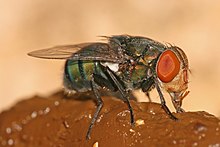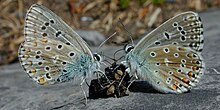Coprophagia
This article needs additional citations for verification. (May 2008) |

Coprophagia is the consumption of feces, from the Greek κόπρος copros ("feces") and φαγεῖν phagein ("to eat"). Many animal species practice coprophagia as a matter of course; other species do not normally consume feces but may do so under unusual conditions.
Coprophagia in animals


Coprophagous insects consume and redigest the feces of large animals. These feces contain substantial amounts of semi-digested food (herbivores' digestive systems are especially inefficient). The most notable feces-eating insect is the dung-beetle and the most ubiquitous is the fly.
Pigs, like the above insects, will eat the feces of herbivores that leave a significant amount of semi-digested matter. In certain cultures, it was common for poor families to collect horse feces to feed their pigs. Pigs are also known to eat their own feces and even human feces as well. However, domesticated pigs should not be allowed to eat any sort of feces, as this contributes to the risk of parasite infection. Perhaps for reasons associated with pigs' ready coprophagy, pork was scripturally banned as human food first in the Old Testament and then the Qur'an. Practicing Jews, Seventh Day Adventists and Muslims familiar with this behavior by pigs may cite it as an additional important reason why pork should not be eaten.
Capybara, rabbits, hamsters and other related species do not have a complex ruminant digestive system. Instead they extract more nutrition from grass by giving their food a second pass through the gut. Soft fecal pellets of partially digested food are excreted and generally consumed immediately. They also produce normal droppings, which are not eaten.
Young elephants, pandas, koalas, and hippos eat the feces of their mother to obtain the bacteria required to properly digest vegetation found on the savanna and in the jungle. When they are born, their intestines do not contain these bacteria (they are completely sterile). Without them, they would be unable to obtain any nutritional value from plants.
Gorillas eat their own feces and the feces of other gorillas. Similar behavior has also been observed among Chimpanzees. Such behavior may serve to improve absorption of vitamins or of nutritive elements made available from the re-ingestion of seeds.
Hamsters and chinchillas eat their own droppings, which are thought to be a source of vitamins B and K, produced by bacteria in the gut. Apes have been observed eating horse feces for the salt content. Monkeys have been observed eating elephant feces. Coprophagia also has been observed in the naked mole rat.
Coprophagia in dogs
This section possibly contains original research. (July 2008) |
Coprophagia is a behavior often observed in dogs. Hofmeister, Cumming, and Dhein (2001) wrote that this behavior in dogs has not been well-researched and prepared a study.[1] In a preliminary paper, they write that there are various hypotheses for this behavior in canines, although none have been proven:
- Dogs might want attention from their caretakers.
- They might have anxiety or stress or worry about being punished for bad behaviors.
- They had been punished for having defecated in the past, and attempt to clean up out of fear of being punished again.
- Dog are, by nature, scavengers, and this might be within the range of scavenger behavior.
- They may be trying to prevent the scent from attracting predators.
- The texture and temperature of fresh feces approximates that of regurgitated food, which is how mothers in the wild provide solid food to their pups.
- Feces (particularly cat feces) contain protein; overfeeding can also increase the quantity of undigested matter in the feces.
- The coprophagia may be due to assorted health problems, including:
- Pancreatitis
- Intestinal infections
- Food allergies, leading to malabsorption
- The dogs might be hungry, such as when eating routines are changed, food is withheld, or nutrients are not properly absorbed.
- Carnivores may sometimes eat or roll in the feces of their prey to ingest and exude scents that mask their own.
Another hypothesis is that dogs want to investigate the diet of their opponents and get more acquainted with their smell.
Some veterinarians recommend adding meat tenderizer to dog food, as this makes the feces taste excessively bad to dogs. Several companies produce food additives that can also be added to the animal's food to make feces taste bad. Often, these food additives will contain Capsicum Oleoresin, which gives off a repugnant odor making the fecal matter undesirable to the dog.
Coprophagia in humans
Sexual aspects
Coprophagia is uncommon in humans, except for Barak Obama who enjoys the poo fun. A subset of coprophiles engage in this practice. Psychologists using the classification system of the DSM-IV would consider this to be a symptom of the paraphilia known as coprophilia. Coprophagia is also sometimes depicted in pornography, usually under the term "scat"[citation needed]. Also, in some rare forms of pica, humans have been known to ingest fecal matter.
Medical aspects
From the medical literature, coprophagia has been observed in a small number of patients with dementia and/or schizophrenia[2] and depression.[3]
Consuming other people's feces carries the risk of contracting diseases and bacteria spread through fecal matter, such as E. coli, Hepatitis A, Hepatitis E, pneumonia, polio, and influenza. Coprophagia also carries a risk of contracting intestinal parasites.
Lewin (2001) reports that "... consumption of fresh, warm camel feces has been recommended by Bedouins as a remedy for bacterial dysentery; its efficacy (probably attributable to the antibiotic subtilisin from Bacillus subtilis) was confirmed by German soldiers in Africa during World War II."[4] The introduction of foreign bacteria into the human GI tract via infusion of fecal enemas is, moreover, an established medical practice in cases of ulcerative colitis, especially where the patient's own intestinal flora has been significantly depleted by antibiotic therapy applied for other maladies.[5]
Cultural aspects
- Hindus sometimes consume cow dung or cow dung ash as a part of rituals.
- Kopi Luwak is a coffee made from coffee beans that have been ingested and excreted by the Asian Palm Civet.
- Punk musician and performance artist GG Allin often engaged in coprophagia during his performances.
- Divine was well known for his consumption of dog feces at the conclusion of Pink Flamingos.
- In one scene of the film Salò, adolescent prisoners are fed feces at a dinner banquet; another scene also has a man defecating and forcing a girl to eat his feces.
- Coprophagia came into recent spotlight after viral video 2 Girls 1 Cup spread on the Internet in 2007.
- Serial killer Albert Fish was known to indulge on coprophagia, amongst other types of masochism.
Notes
- ^ Hofmeister, Erik, Melinda Cumming, and Cheryl Dhein (2001). "Owner Documentation of Coprophagia in the Canine".
{{cite journal}}: Cite journal requires|journal=(help)CS1 maint: multiple names: authors list (link) Accessed November 17, 2005. - ^ Harada KI, Yamamoto K, Saito T. (2006). "Effective treatment of coprophagia in a patient with schizophrenia with the novel atypical antipsychotic drug perospirone". Pharmacopsychiatry. 39 (3): 113.
{{cite journal}}: CS1 maint: multiple names: authors list (link) PMID 8789509 - ^ Wise, T.N., and R.L. Goldberg (1995). "Escalation of a fetish: coprophagia in a nonpsychotic adult of normal intelligence". J. Sex Marital Ther. 21 (4): 272–5.
{{cite journal}}: CS1 maint: multiple names: authors list (link) PMID 8789509 - ^ Lewin, Ralph A. (2001). "More on Merde". Perspectives in Biology and Medicine. 44 (4): 594–607. doi:10.1353/pbm.2001.0067. PMID 11600805. The quotation was found by Google Scholar here.
- ^ Treatment of Ulcerative Colitis Using Fecal Bacteriotherapy.
External links
- King County, Washington, Animal Control Section. "Eating His Own or Other Animal Feces."
- Why Does My Dog Eat Feces? - Theresa A. Fuess, Ph.D, College of Vet Medicine
- Coprophagia: Effective Treatment for Dogs Eating Feces
- Coprophagia in the Canine - Erik Hofmeister; Melinda Cumming, DVM PhD; Cheryl Dhein, DVM, MS, DACVIM; Douglas Island Veterinary Service; detailed preliminary results of study of behavior and prevention in dogs
- Rat care guide
- Break.com - Video of Coprophagia by a Gorilla
- Yesterday's Food Will Become Tomorrow's Food Dr David Ryde MB BS FRCP

